:::::::::::::::::::::::::::::::::::::::::::::::::::::::::::::::::::::::::::::::::::::::::::::::::::::::::::::::::::::::::::::::::::::::::::::::::::::::::::::::::::::::::::
| Abe no Seimei 阿倍晴明 (921 - 1005)  quote Abe no Seimei 安倍晴明 ( February 21, 921 – October 31, 1005) was an onmyōji, a leading specialist of onmyōdō during the middle of the Heian Period in Japan. In addition to his prominence in history, he is a legendary figure in Japanese folklore and has been portrayed in a number of stories and films. Seimei worked as onmyōji for emperors and the Heian government, making calendars and advising on the spiritually correct way to deal with issues. He prayed for the well-being of emperors and the government as well as advising on various issues. He was also an astrologist and predicted astrological events. He enjoyed an extremely long life, free from any major illness, which contributed to the popular belief that he had mystical powers. The Seimei Shrine, located in Kyoto, is a popular shrine dedicated to him. The Abeno train station and district, in Osaka, are sometimes said to be named after him, as it is one of the locations where legends place his birth. © More in the WIKIPEDIA ! He performed a lot of rituals to heal people of high rank and his power in this respect is now attributed to the placebo effect プラセボ効果 known to modern medicine. . Healing the headache of Emperor Kazan 花山天皇 . .................................................................................................................................................................. His mother is said to have been a fox called Kuzu no ha, Kuzunoha 葛の葉 As a child, Abe painted her portrait. He gained his magical powers from his mother. 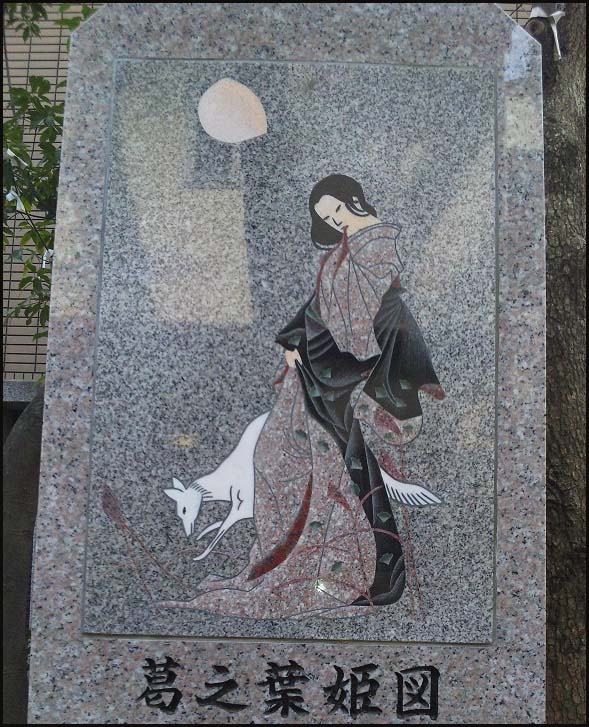 葛の葉のうらみ顔なる細雨かな 葛の葉の 恨み顔なる 細雨(こさめ)哉 // ( 細雨 also read sai-u ) kuzu no ha no uramigao naru kosame kana this drizzling rain almost like the resentful face of Lady Kuzunoha . . . The light rain here represents the tears of Lady Kuzunoha when leaving her baby behind, because her husband found out she was a fox. kuzunoha in Haiku is often used implying the feeling of a grudge, bitterness and resentment. . Yosa Buson 与謝蕪村 in Edo . 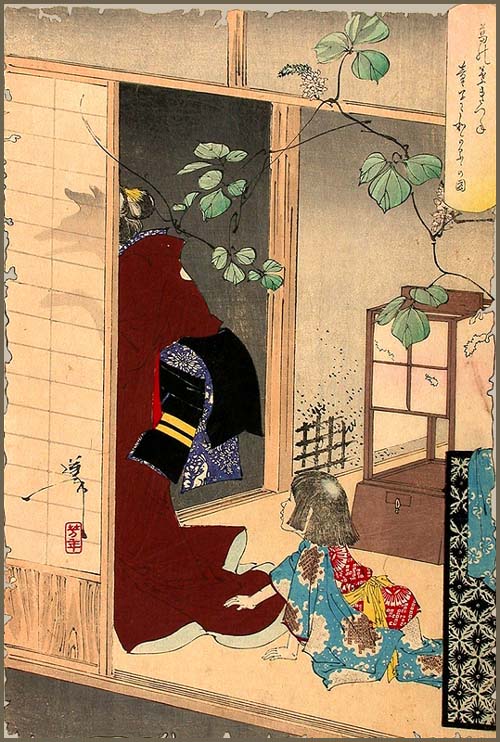 The Fox-woman Kuzunoha Leaving Her Child - Tsukioka Yoshitoshi 月岡 芳年 - - - More in the WIKIPEDIA ! - Lady Kuzunoha . kuzu no ha 葛の葉 arrowroot leaves . kigo for autumn ..................................................................................................................................................................  yakuyoke momo 厄除桃 Peach to ward off evil 清明神社 Seimei Jinja quote An image of a peach, also, is celebrated in this shrine. In ancient China and Yin and Yang religion, peaches are said to be the fruit for talismans and to ward off evil. In the Kojiki and Nihon Kojiki (two famous works of ancient Japan) the images of people using peaches to chase away evil spirits can be seen. The bedtime story which most Japanese people know, Momotaro (a story about a boy born from a peach who later went on to conquer the land of ogres) also derives from this belief. By rubbing one’s evil and ominous things onto this peach, they are said to be able to become refreshed and calm. source : the-merlin-of-japan . Amulets to ward off evil . . momo 桃 peach fruit art motives . . WKD : Yin and Yang 陰陽 . .............................................................................................................................................. Shikigami 式神 / シキガミ, Shiki no Kami 式の神 Shiki deity, demon or ghost god-like demon spirits 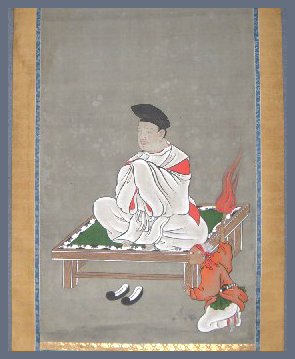 The Shikigami is on the bottom of the right side, clad in red. - quote - Shikigami 式神, also read as Shiki-no-kami, 式の神 the term for a being from Japanese folklore. It is thought to be some sort of kami, represented by a small ghost. The belief of shikigami originates from Onmyōdō. Shikigami are said to be invisible most of the time, but they can be made visible by banning them into small, folded and artfully cut paper manikins. There are also shikigami that can show themselves as animals or birds. They must be conjured during a complex ceremony and their power is connected to the spiritual force of their master. If the evoker is well introduced and has lots of experience, his Shiki can possess animals and even people and manipulate them. But if the evoker is careless, his shikigami may get out of control in time, gaining its own will and consciousness. In this case the shikigami will raid its own master and kill him in revenge. Normally shikigami are conjured to exercise risky orders for their masters, such as spying around, stealing and enemy tracking. . . . - - - More in the WIKIPEDIA ! shikigamitsukai 式神遣 a kind of sorcerer, witch izunatsukai 飯縄遣 witch helping Izuna inugamizukai 犬神使い using a dog deity kitsunetsukai 狐使い using a fox deity This is often a 霊狐 special fox, performing special rituals with respect to various deities, like Iizuna 飯綱法、Atago 愛宕法、Dakini 茶吉尼法 Abe no Seimei used a various Shikigami or oni 鬼 demons to help with his magic work and there were many others he had to subdue.  陰陽師鬼談 安倍晴明物語 / kidan 鬼談 Demon stories about Abe no Seimei 荒俣宏 Aramata Hiroshi 芦屋道満 Ashiya Doman との確執 Ashiya Doman is an arch rival of Abe no Seimei and the Spirit Guardian of Adashino Benio 伴侶-息長姫 との竜宮での出会い Okinagahime in the Dragon Palace、 橋姫との契り Hashihime . Hashihime, Hashi Hime 橋姫 / はし姫 "Princess of the Bridge" . - quotes - -- When the samurai Watanabe no Tsuna was said to cut off a demon's arm, he brought the accursed item to Seimei to seal it away with a spell. ... -- Seimei remarks that the world is gradually returning to its proper shape with the demons' purifications, yet the time distortions created by the monstrosities ... -- Legend says that Seimei met hosts of other demons in magical situations ... - further reference : abe seimei demons -  . Onipedia - 鬼ペディア - Oni Demons - ABC-List - . ::::::::::::::::::::::::::::::::::::::::::::::::::::::::::::::::::::::::::::::::::::::::::::::::::::::::::::::::::::::::::::::::::::::::::::::::::::::::::::::::::::::::::: There are various shrines of Seimei in Japan.  - quote Seimei Shrine (晴明神社 Seimei-jinja) is a Shinto shrine that is located in Kyoto, Japan. It is dedicated to the onmyōji, Abe no Seimei. The Seimei Shrine was founded on the 4th year of the Kankō era (1007) by Emperor Ichijō, who ordered the shrine built in memory of Abe no Seimei, after his death in 1005. It was constructed on the site of Abe no Seimei's house. The main building was restored in 1925. Two torii gates lead up to the entrance of the shrine. A famous well (Seimei-i) is located on the shrine grounds, and the water drawn from it is considered somewhat magical. Tea master Sen no Rikyū was known to have brewed tea with the water from this well. The pentacle, known locally as a Seimei-star, is an important symbol found on many parts of the shrine. Abe no Seimei reputedly came up with the arcane insignia in the 10th century, symbolizing the Five Chinese Elements. Japanese bellflower (Platycodon grandiflorus) ornamentation are found in decorative tiles and lanterns. The five petal tips of the flower are thought to represent the same ideal as the pentagram. A nearby bridge, the Ichijō Modori-bashi is situated just south of the shrine, and is held to be a gateway between the human and spiritual realms. Seimei Matsuri (晴明祭) Seimei Festival is held every year on the Autumnal equinox. © More in the WIKIPEDIA !    CLICK for more talismans ! . O-Mamori お守り Talismans from Japan .  source : kyoto-k.sakura.ne.jp .............................................................................................................................................. . godai ... 地水火風空の五大 The Five Elements of the Universe . goboosei, gobōsei 五芒星 Gobosei, pentagram, five-sided star Abe no Seimei used this pentagram as an amulet to ward off evil influence. It contains the essence of the theory of the five elements. abe no seimeiban 安倍晴明判 "seal of Abe no Seimei" seimei kuji 晴明九字 "nine letters of Seimei" kikyoo in 桔梗印 seal of the Japanese bellflower (Platycodon grandiflorus) seimei kikyoo 晴明桔梗 "Bellflower of Seimei"  on the stamp of Seimei shrine  at the well of Seimei shrine - 晴明井  source : apsatyan.exblog.jp grave with pentagram pattern 晴明桔梗の紋が石碑  The pentagram is also used as a family crest.  - source : apsatyan.exblog.jp The Bellflower as a family crest. . Fudo Myo-O and the Pentagram . . Family Crest 家紋 kamon - Familienwappen .  seimei kuji 晴明九字 "nine letters of Seimei" Kuji were often painted, engraved, or embroidered on various objects or places as a talisman. .................................................................................................................................................................. The Worship of Stars in Japanese Religious Practice (2006) edited by Lucia Dolce - source : www.cultureandcosmos.org Five - Number's Importance in Chinese and Japanese Buddhism source : Mark Schumacher . Reference : Abe no Seimei Onmyodo, onmyoodoo 陰陽道 Onmyo-Do The Way of Yin and Yang Hyakkaisai 百怪祭 Festival of 100 Monsters . Legends of the Heian Period (794 to 1185) 平安時代の伝説 . ::::::::::::::::::::::::::::::::::::::::::::::::::::::::::::::::::::::::::::::::::::::::::::::::::::::::::::::::::::::::::::::::::::::::::::::::::::::::::::::::::::::::::: Tsuchimikado, Tsuchi no Mikado 土御門天皇 (January 3, 1196 – November 6, 1231) - reigned from 1198 to 1210. a branch-family of Abe no Seimei - 安倍氏(土御門家)の祖 土御門家に伝わった 占事略决 senji ryakketsu (せんじりゃっけつ、せんじりゃくけつ) 晴明の子孫である土御門家での伝承の存在 Tsuchimikado's official Imperial tomb is in Kyoto. The emperor is venerated at a memorial Shinto shrine (misasagi). This mausoleum shrine is formally named Kanegahara no misasagi. Senji Ryakketsu 占事略决 lit. The Summary to Judgements of Divinations is one of the texts written by the legendary Abe no Seimei during the Heian Period in Japan. It is attributed to Seimei since it contains a chapter that clearly bears his name. The text contains six thousand forecast and thirty-six fortune-telling techniques based on divination through use of shikigami. Many of these divinations relate to normal daily lives such as determining the gender of an unborn child, finding lost or missing objects, and advice on how to lead one's personal life. - - - More in the WIKIPEDIA ! :::::::::::::::::::::::::::::::::::::::::::::::::::::::::::::::::::::::::::::::::::::::::::::::::::::::::::::::::::::::::::::::::::::::::::::::::::::::::::::::::::::::::::  onigawara with a pentagram said to be the only one in Japan. at temple 妙心寺 Myoshin-Ji, Kyoto. To protect the whole town from evil influence. . Demon Gable Tiles, Onigawara 鬼瓦 . ::::::::::::::::::::::::::::::::::::::::::::::::::::::::::::::::::::::::::::::::::::::::::::::::::::::::::::::::::::::::::::::::::::::::::::::::::::::::::::::::::::::::::: Weeping Fudo . Naki Fudo 泣き不動 - 清浄華院 Shojoke-In - - - - - and one more legend about Abe and Fudo At the temple hall Shinnyodoo 真如堂 Shinnyo-Do 京都府京都市左京区浄土寺真如町82 Kyoto The statue of Fudo Myo-O at this temple was the special protector deity of Abe no Seimei. One day his descendants wanted to have it back. Tenno Gohanasono-In 後花園院 (1419 - 1470) did not want to accept this request and had the statue transported to his private living quaters (kinri 禁裏). When he opened the box it was empty and Fudo Myo-O had returned to the Shinnyo-Do. This Fudo statue was used to be looking East 東向き but now was facing North 北向き. The adescendants gave up their request and worshipped the Fudo Statue now at Shinnyo-Do.  - Homepage of the temple - source : http://shin-nyo-do.jp/ - The temple has a clay bell with 二面鈴 "two faces" (nimenn suzu) , O-Kame and the Hanya Demon .  能面 Noh-mask of Okame  般若 Hanya . Kyoto no dorei 京都の土鈴 clay bells from Kyoto . .............................................................................................................................................. . The rokuyō (六曜) Rokuyo : Six Days predicting good or bad fortune for each day . The Four Heavenly Directions 東西南北 . Feng Shui 風水 Chinese Geomancy The Asian Lunar Calendar Goshiki 五色 The Five Colors The 12 Heavenly Generals 十二神将 . Kimon 鬼門 the "Demon Gate" . in the North-East .............................................................................................................................................. . Legends from Japan 伝説 - Introduction . There is a keyaki 欅 zelkova tree in 亀岡市 Kameoka that was planted by Abe no Seimei. If people want to cut it or hurt it, they will be cursed. Seimei once lived in Kozagawa 古座川町. He pulled a golden staff 金の棒 behind him, reciting: 知らざる者こそ不憫なれ Thus he could help poor people. ....................................................................... Fukushima 福島 Seimei no Matsu 晴明の松 The Pine tree of Abe no Seimei Once when Seimei travelled in the region, he planted this pine with the wish to protect people from fire and disaster and founded the shrine 小社山神社 (Okosoyama Jinja). The tree has been cut down in the Meiji period, it is said its diameter was 9 shaku (1 shaku is about 30 cm). Some say this is the Ipponmatsu at Kamata 鎌田の一本松. 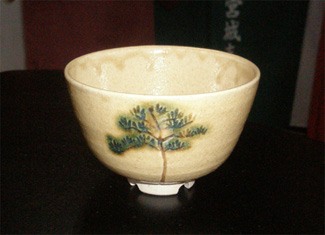 source : kazenomorituushin.blog This is a tea bowl with the Ipponmatsu that survived the Great Earthquake. 東日本大震災の大津波に耐え残った高田松原の「奇跡の一本松」が描かれたお茶碗. ....................................................................... Gifu 岐阜 yakan 野干 a monster beast from ancient China probably ジャッカル jakkaru, jackal, or maybe a fox 狐. (more about the yakan, see below) Once a man from Mino wanted to get a beautiful wife and eventually found one in Nohara 野原 (The Wilderness). He took her as his wive and they had a son. Soon after the dog of the home also had youngens, which were born on the 15th day of the 12th lunar month (full moon night). There puppies seemed quite grown-up at birth and when they saw the lady of the house, they yelped. One day when the women wanted to do the washing of rice for lunch and went into the little hut with running water. There they found the dog trying to bite and eat their mistress. The Mistress suddenly turned into a Yakan Fox and fled over the roof. Seimei's mother is said to have been a fox called Kuzu no ha 葛の葉.  (photo : wikipedia) ....................................................................... Abe no Kiyoyuki 安部清行, a descendant of Seimei (825 - 900) One evening Kiyoyuki passed a small road near 神泉苑 Shinsen-En Garden ("Sacred Spring Garden") when he saw some children draging the sacred rope of the temple through the mud. He felt as if he was hurt himself and scolded the children in a loud voice. - Homepage of Shinsen-En - 京都府京都市中京区御池 It is the remains of the palace and garden of Emperor Kanmu. - source : www.shinsenen.org - - quote - Shinsen-en was once much larger, about 10 times bigger covering 33 acres, in fact, and was part of a walled Chinese-style pleasure garden built by Emperor Kammu to the south of his main palace. Shinsen-en stretched between Nijo to Sanjo streets. Due to numerous fires nothing remains of the Emperor Kammu's original structures and the garden has survived as the Tokugawa authorities allowed Toji Temple to construct a sub-temple here along with three small Shinto shrines. Shinsen-en garden was once the playground of the Heian nobility who held moon-viewing and boating parties on the lake. The name of the street on which Shinsen-en stands, Oike Dori, harks back to the glory days of the garden as it means "Honorable Pond" street. - source : Japan Visitor - . The Park of God's Well in Kyoto . Already during the Heian period, a dragon was believed to live in the park and if you pray sincerely to it, rain would fall. .............................................................................................................................................. yakan 野干 a monster beast from ancient China probably ジャッカル jakkaru, jackal, or maybe a fox 狐. . Tamamo no Mae 玉藻前 - Tamamo Gozen 玉藻御前 . . She is also a 野干玉藻 Yakan Tamamo Fox. In Gifu near the village of 濃州安八郡春近村 there lived an old fox (yakan) in the estate of the family of 井上与三郎 Inoue Yosaburo. He was friendly with people and they called him 板益亥正 or Baian 梅庵. He lived there for more than 300 years, writing books, practising Zen meditation, helping people with his knowledge of medicine and educating the children of the Inoue family. In Iga, the fox is called yakan, or Igatoome 伊賀専女 And a white fox is called 専御前. In Miyagi there is a slope called やかん坂 Yakanzaka. At night a yakan (also spelled 薬缶 or 野狐) comes rolling down this slope. yakan is also the word for a kettle to heat water and prepare medicine. . A Yakan from Osaka . ....................................................................... - source : yokai database - . kitsune 狐 fox legends . - Introduction - ::::::::::::::::::::::::::::::::::::::::::::::::::::::::::::::::::::::::::::::::::::::::::::::::::::::::::::::::::::::::::::::::::::::::::::::::::::::::::::::::::::::::::: 秋たつや何におどろく陰陽師 (おんみょうじ) aki tatsu ya nani ni odoroku onmyooji (Blyth is quoted as writing "inyôshi".) Suddenly, fall chill... Why should that ragged fortune teller look so surprised? Tr. Peter Beilenson autumn begins - why is the fortune-teller looking so surprised? Tr. Gabi Greve . Yosa Buson 与謝蕪村 in Edo . This is an allusion to a waka by Fujiwara no Toshiyuki 藤原敏行: 秋きぬと目にはさやかに見えねども、風の音にぞおどろかれぬる aki kinu to me ni wa sayaka ni miene domo, kaze no oto ni zo odorokarenuru quote Nothing meets the eye to demonstrate beyond a doubt that autumn has come - yet suddenly I am surprised to the sound of wind. This Waka poem was written by Fujiwara no Toshiyuki and is included in an old compilation of Tanka poetry called “Kokin Wakashu.” The ‘kinu’ in ‘Aki kinu to’ means ‘has come.’ ‘Sayaka’ means ‘clearly.’ ‘Miene domo’ is another way of saying ‘mienai keredo’ or ‘can’t see it but…’ ‘Odorokarenuru’ means to ‘realize something surprisingly.’ So in other words, the poem means “Hot days had continued, so I thought it was still summer. But it wasn’t so. I couldn’t see clearly that autumn had come, but the sound of wind made me aware of autumn’s approach. The scenery looks the same as yesterday - a scene of summer - but the sound of the wind is clearly announcing the coming of autumn.” This is one example of how autumn can be experienced through sound. source : blogs.japanesepod101.com ::::::::::::::::::::::::::::::::::::::::::::::::::::::::::::::::::::::::::::::::::::::::::::::::::::::::::::::::::::::::::::::::::::::::::::::::::::::::::::::::::::::::::: Onmyooji 陰陽師 Onmyoji  - quote - Onmyouji (陰陽師) is a Japanese movie that was released in 2001 and sent to the US in 2004. Directed by Yōjirō Takita, it tells of the exploits of Abe no Seimei, in Middle Ages, the Onmyouji (also known as: The Yin Yang Master) from the court of the Emperor. He befriended bungling court noble, Minamoto no Hiromasa, who enlists his aid to defend the Heian emperor. Meanwhile, an opposing onmyoji Doson is plotting the downfall of the emperor, while attempting to frame Seimei by unleashing a horde of yōkai to do his bidding. Mansai Nomura Mansai 野村萬斎 - Abe no Seimei Nomura Mansai II / 二世 野村 萬斎 Nisei Nomura Mansai born April 5, 1966 under the name Takeshi Nomura (野村 武司 Nomura Takeshi)), is a well known Kyogen stage actor, and film actor. He played Abe no seimei in Onmyoji and Onmyoji 2, an original work by Baku Yumemakura. He received the Best Actor prize at the Blue Ribbon Awards for his work in Onmyoji. - - - More in the WIKIPEDIA ! Nomura Mansai had an interview with the upcoming figure skater Hanyu Yuzuru Hanyu, who uses the music of the movie Seimei for his performance. Mansai showed him how to act his feelings . . . and much more in a memorable TV interview. Later Yuzuru improved his style a lot and made it to the top in December 2015.  Yuzuru visiting Seimei Jinja on July 2. Yuzuru Hanyu . Hanyuu 羽生結弦 Hanyū Yuzuru (born 7 December 1994) is a Japanese figure skater who competes in the men's singles discipline. - snip - 2015–16 season For the 2015–16 season, Hanyu decided to expand on his performing scale and skate to a Japanese-themed free skating with music from the film soundtrack of Onmyoji where he would try portraying 10th century astronomer, Abe no Seimei. He also met up with Mansai Nomura, the actor who portrayed Seimei in the film to get advice on how to portray him. At the 2015 NHK Trophy, Yuzuru Hanyu placed first in the short program with a world record score of 106.33. At the 2015–16 Grand Prix Final in Barcelona, Hanyu broke his short program record, totaling a score of 110.95 points. - - - More in the WIKIPEDIA ! 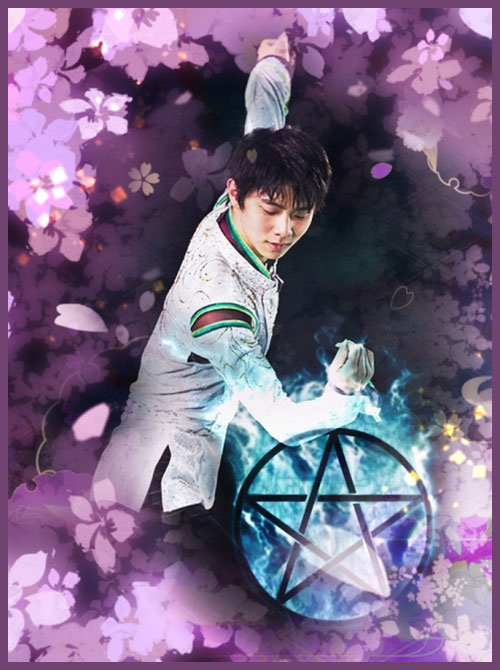 |
:::::::::::::::::::::::::::::::::::::::::::::::::::::::::::::::::::::::::::::::::::::::::::::::::::::::::::::::::::::::::::::::::::::::::::::::::::::::::::::::::::::::::::
[ . BACK to WORLDKIGO . TOP . ]
[ . BACK to DARUMA MUSEUM TOP . ]
- #abenoseimei #onmyoji #nomuramansai -
:::::::::::::::::::::::::::::::::::::::::::::::::::::::::::::::::::::::::::::::::::::::::::::::::::::::::::::::::::::::::::::::::::::::::::::::::::::::::::::::::::::::::::
8 comments:
Tao, Dao and Haiku
http://happyhaiku.blogspot.jp/2005/06/tao-dao-and-haiku.html
泰山府君 Taizan Fukun
Taizan-ō, 泰山王 King of Hell, Judge in the 7th week, 49th day 七七日49日
.
Tono Seven Kannon Pilgrims 遠野 七観音 The Seven Kannon of Tono
Layed out in the form of the pentagram.
不動利益縁起絵巻 - Fudo Riyaku Engi Emaki
- 鎌倉期14Cより - 泣不動縁起絵, 証空絵詞
From temple 三井寺 Mitsuidera.
.
Yakubyoogami 疫病神 Yakubyogami, Deity of Diseases
eyami no kami えやみのかみ
Taizan Fukun 泰山府君 / 太山府君 King of Hell
Taizan-O 太山王(泰山王) King Taizan
and the ceremony
泰山府君祭 Taizan Fukun no Sai
practised by Abe no Seimei
.
https://gokurakuparadies.blogspot.jp/2017/08/taizan-fukun-hell-king.html
.
....... Fukui 福井県
遠敷郡 Onyū - Onyu district 名田庄村 Natashomura
Osaizangitsune おさいざん狐 a fox named O-Saizan
On a rock above the shrine 加茂神社 Kamo Jinja there lives a 白狐 white fox called O-Saizan. He/she is the protector of Taizan Fukun.
The 狐の火の玉 fire ball of the fox can fly from 天壇 the heavenly abode of Taizan Fukun all the way to this Kamo Shrine.
加茂神社 Kamo Jinja
福井県大飯郡おおい町名田庄納田終127-4
After the Ōnin War 応仁の乱 Onin no Ran in 1467, members of 土御門家 the clan of Tsuchimmikado (from a branch-family of Abe no Seimei 阿倍晴明 (921 - 1005)) fled here. They were strong believers in the power of Kamo Jinja shrine in Kyoto and spread the belief in this shrine in the region.
In the village there are still many thatched-roof houses that have retained their form for centuries.
.
https://gokurakuparadies.blogspot.jp/2017/08/taizan-fukun-hell-king.html
.
Tokyo Suginami Yakanzaka
薬缶坂 The monster from Yakanzaka
It used to prevent people from passing this slope. When a person stopped walking, the Yakan also stopped walking. Then the Yakan would stand up on its hind legs and dance.
The Yakan was often seen on rainy nights.
.
https://edoflourishing.blogspot.com/2018/06/suginami-ward.html
.
Nagano said, "The story of Abe no Seimei, also known as Kitai no doji, was well known to people in the Edo period. Although we cannot make conclusions at present, research may progress if new historical records emerge in future."
Japanese folklore creature Amabie, said to ward off plagues, has caused a sensation during the coronavirus pandemic. But in the shadow of the popular "yokai" creature's resurgence, research continues into historical records of "Kitai no doji," another plague-fighting folklore creature characterized by sharp fangs and glowering eyes.
Kitai no doji is said to have emerged from Kanda Myojin Shrine in the heart of Edo, now Tokyo's Chiyoda Ward, in 1858 toward the end of the Edo period (1603-1867). The year was one of political instability for Japan and marked the beginning of the Ansei Purge, in which a major crackdown on dissenters by the Tokugawa shogunate's "Tairo" chief minister Ii Naosuke took place. In addition, a cholera epidemic raged across the country in a way similar to the current coronavirus crisis.
more
https://mainichi.jp/english/articles/20210626/p2a/00m/0na/016000c
.
Post a Comment